
The Free Press

Richard Glossip has been scheduled to die nine times. He’s had three last meals. He’s said farewell to his wife, Lea, five times. And every time, he’s been granted a stay or an appeal—another chance.
Now, a quarter-century after being convicted of a murder almost everyone agrees he is not guilty of, his long, tortuous journey is nearing its climax.
All of which is to say that, in the not-too-distant future, Glossip, 60, will be dead, or he will be the man who brings down the death penalty in one of the most pro–death penalty states in the country. Or possibly, even, both.
Last week, the Supreme Court agreed to hear Glossip’s case and determine whether he deserves a new trial. “What’s important now is showing people that they made a huge mistake,” Glossip told me. “I am here because of what happened then, but I don’t have to live in the past—what happened then. It’s about fixing it now.”
We spoke on the phone—me from the apartment in Oklahoma City, where his wife Lea lives; Glossip from the penitentiary in McAlester, Oklahoma, a little over two hours away.
There are 27 states with capital punishment, but just a handful do most of the executing, with Texas in first place and Oklahoma at No. 2. (Oklahoma, with its much smaller population, actually has a higher execution rate than Texas does.)
Glossip, who has spent the past two decades in solitary confinement, has long believed that he had little hope.
For years, he had managed to delay his execution with appeals and stays, and he had even come to terms with his sentence. “You have to make peace with death so you can live,” Glossip said. He had expected that, when the deed was finally done, it would be relatively painless.
Listen to Richard Glossip talk to The Free Press by clicking each of the audio segments below:
But then, in April 2014, things got really scary.
That was when Oklahoma executed Clayton Lockett, in the same prison Glossip was confined to, in the same execution chamber where Glossip expected to die. Prison officials used an untested mix of chemicals—including potassium acetate—rather than the state-prescribed potassium chloride, as well as the controversial sedative midazolam, on Lockett. And they botched it. Because the IV line was not properly placed, the drugs were absorbed into surrounding tissue instead of his vein.
It took 43 minutes for Lockett to die. He woke up, he writhed, he even tried to get off the table. He suffered.
When I asked Glossip about this, he seemed unsure of how to reply.
“It made me nervous,” was all he said.
The Lockett fiasco did not stop Oklahoma from moving forward with plans for Glossip’s execution. He was scheduled to die, for a fourth time, on September 30, 2015.
He called that day “the most difficult day of my life.”
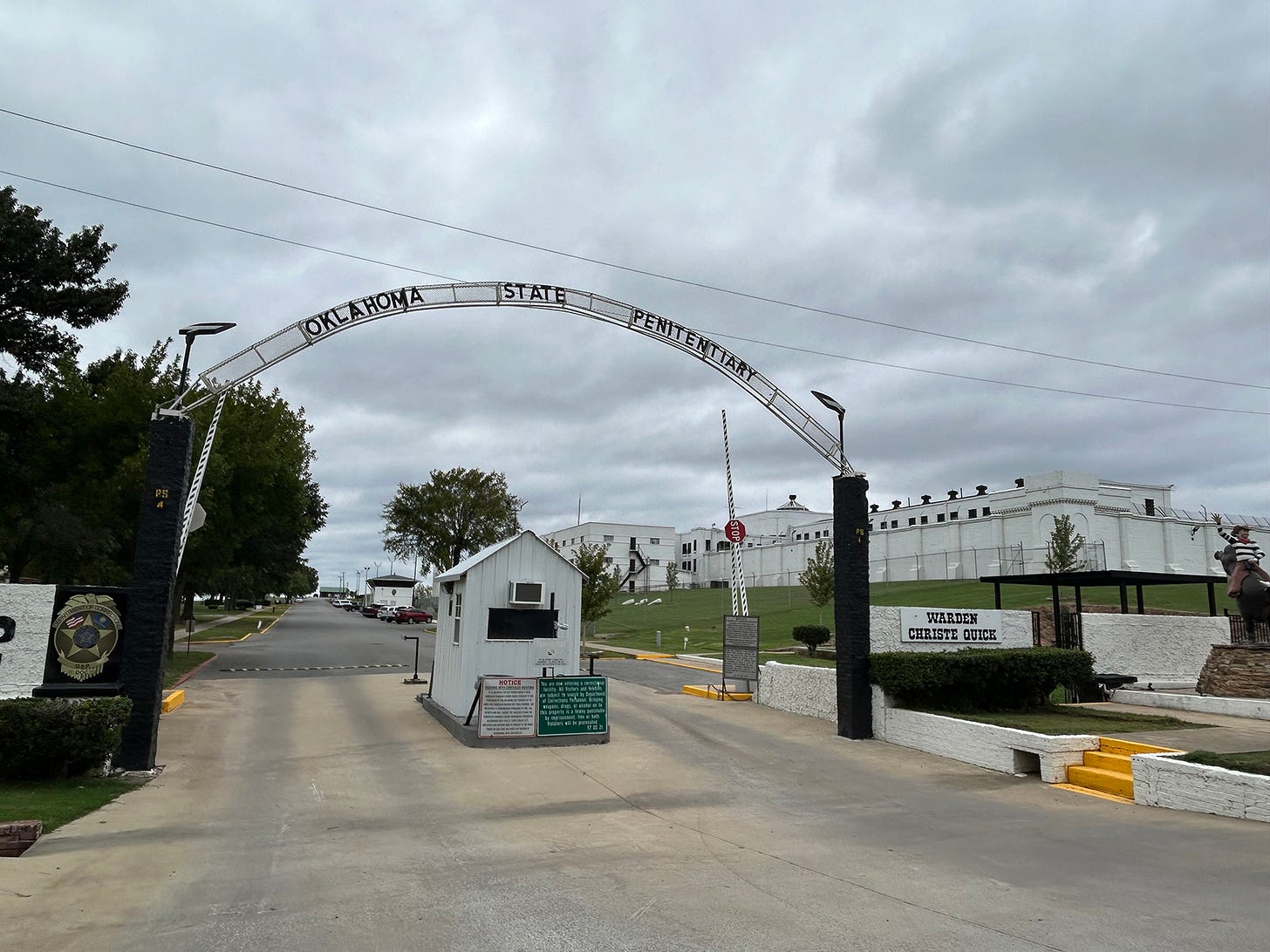
It was nearing 3 p.m., when his execution was supposed to happen, and from his cell he could hear lots of activity—people, hushed voices, doors opening and closing. Then nothing. No guards appeared at his cell ready to escort him to the execution chamber. He was just sitting there in his underwear. (You have to undress before they execute you.)
“I was begging for some answers,” Glossip said. “Nobody was giving me any answers, and I’m in the cell freezing. I’ve probably never prayed harder in my life. The things that I prayed for was kind of crazy—like I had to live until the Cubs won the World Series.”
Then, at 3 p.m., just as he was about to pass from this world, Glossip heard a low, haunting rumble echoing from the first floor of the building, engulfing the whole of death row. It was the other inmates kicking on their cell doors.
“When somebody’s being executed, they kick the doors,” Glossip explained. Over the years, Glossip said, he’d kicked his own cell door many times. “It’s a send-off—letting them know that people are thinking of them.”
Finally—he wasn’t sure how much time had elapsed—the warden came to Glossip’s cell and explained that they couldn’t find anyone to administer the lethal injection. Governor Mary Fallin had called off the execution because they didn’t have the right drugs.
“A medical professional inside the chamber. . . stood up and said, ‘This is the wrong drug, and I’m not going to give it to him,’ ” said Glossip of the reason he escaped death once again.
Oklahoma uses three drugs for its lethal injection procedure: the first to sedate, the second to paralyze, the third to stop the heart. Potassium chloride is the third drug given, per state rules. But on the date of Glossip’s execution, the state had purchased potassium acetate rather than potassium chloride, just as they had done with Lockett. Plus, there were concerns about the sedative midazolam, which Oklahoma had switched to because the makers of more reliable barbiturates did not want their drugs used to kill people.
What’s more, there weren’t any backup guards trained in venipuncture, the puncture of a vein, because fewer and fewer of them wanted to be associated with capital punishment, a former corrections officer told The Free Press.
Glossip called the last-minute stay “divine intervention.”
It was also the beginning of Richard Glossip’s transformation into a cause célèbre—one that would bridge political parties and prompt a reassessment of the death penalty in a state that is so pro–capital punishment it has shielded it from court challenges by enshrining it in its state constitution.
Glossip had already attracted the support of high-profile death penalty opponents such as the Innocence Project, Sister Helen Prejean, and progressives like Susan Sarandon, who played Prejean in the 1995 film Dead Man Walking.
That wasn’t surprising.
What was surprising was that longtime supporters of capital punishment in deep-red Oklahoma, including many Republican state legislators, were starting to question the Glossip case: his arrest, the investigation, the prosecution, everything. Nor was it just about Glossip anymore. It was about capital punishment. It was about the system. How many human beings were on death row for crimes they hadn’t committed? How many—and this was a terrifying question no one wanted to ask—who were innocent had already been put to death?
“The Glossip case made me question capital punishment,” Kevin McDugle, a Republican in Oklahoma’s House of Representatives, told me.
Other GOP members, he added, are rethinking their position on the death penalty as well. “It’s happened over a long period of time, with them seeing evidence of flaws in our system,” McDugle said.
And yet, the system seems to have a life of its own. Even though a growing number of prominent Republicans, including the state attorney general and Oklahoma’s Republican governor, now believe that Glossip has been deeply wronged, they cannot—however unbelievable this may sound—simply stop his execution.
In Oklahoma, the governor can commute a death sentence only if the state’s Pardon and Parole Board gives the okay. And the board has so far refused to do that.
For now, Glossip will live until the Supreme Court decides whether or not he should be tried again. Some believe that if his death comes at the hands of the state, his end will also be the end of executions in Oklahoma.
“If Richard Glossip is put to death,” McDugle said, “you’ll see members of the House of Representatives abolish the death penalty.”

Long before he got tangled up in this mess, Glossip was born into a sprawling family, in a little town called Galesburg, Illinois, east of the Iowa state line. Eight boys, eight girls.
Glossip’s dad, Heron Glossip, served in World War II and worked a slew of factory jobs. His mom worked at a nursing home and in the house—cooking, cleaning, folding laundry, and later, sewing and tending to her vegetable and flower gardens.
Glossip dropped out of high school when he was 14. He wanted to leave his home, which he called “chaotic.” (When his mother, Sally Glossip, died in 2013, she had 58 grandchildren and 60 great-grandchildren.)
He met his first wife when he was 16, and that resulted in two children. Then he met another woman, and that led to two more. Eventually, he wound up in Oklahoma City, where he had a grandmother. He was not a model citizen—it appears he walked away from his kids, and his life wasn’t really going anywhere—but he had no criminal record.
In Oklahoma City, he was a manager at a Domino’s Pizza, which he says was “fun” and he “liked a lot.” Later, he became a general manager at the city’s Grand Continental Hotel. In 1995, he landed a role managing the Best Budget Inn, just off the highway, after a hotel coworker recommended him for the job.
Glossip, who was then 33, and his girlfriend at the time lived in an apartment at the motel. So did Justin Sneed, 19, a maintenance man Glossip had hired, and Sneed’s girlfriend, a stripper named Fancy who worked at the Vegas Club next door.
In the early morning of January 7, 1997, all four of them were at the motel when the owner, Barry Van Treese, showed up.
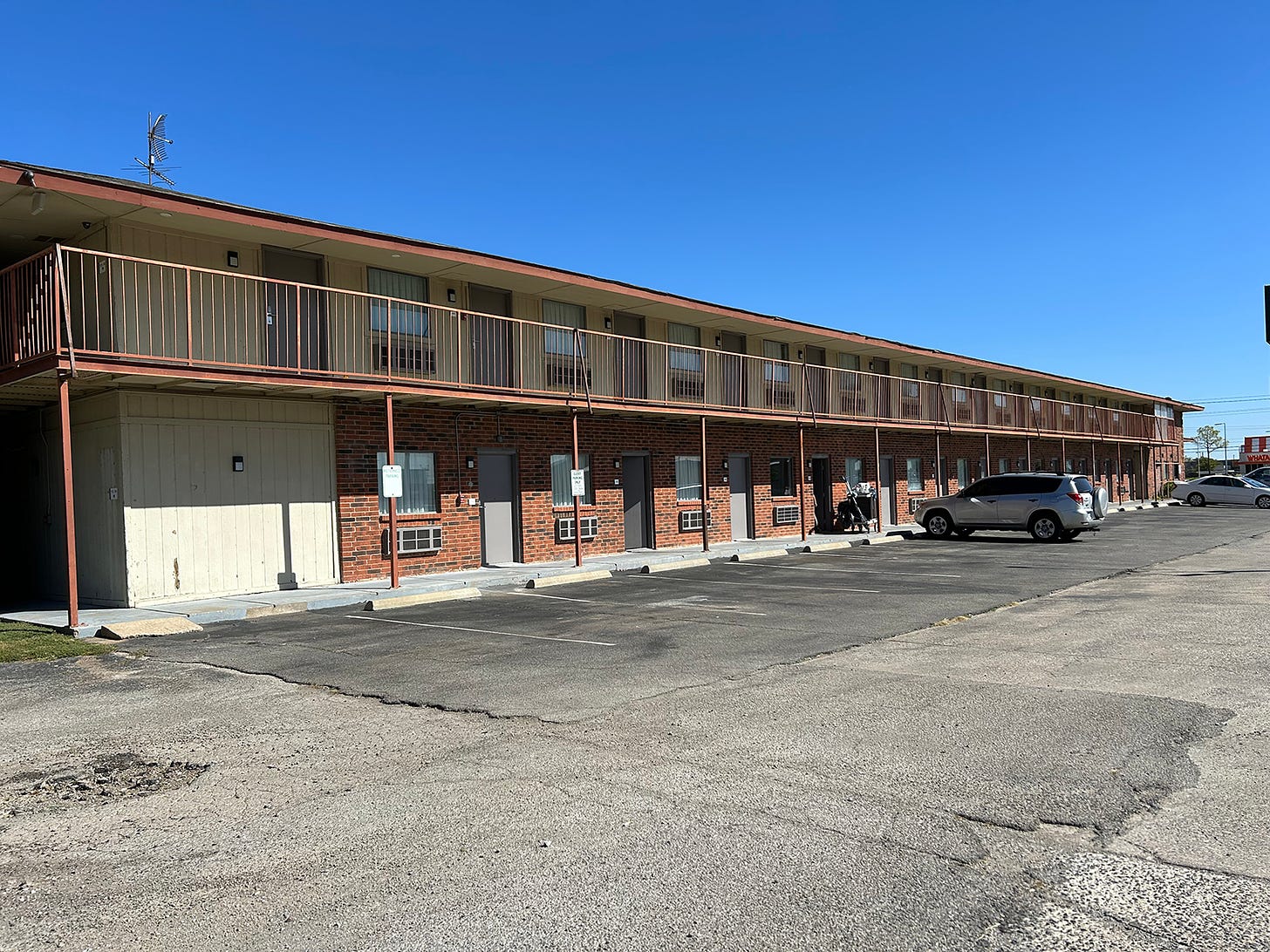
Below is an account of what happened, according to an independent report commissioned in June 2022 by a bipartisan group of Oklahoma state legislators:
Between 2 a.m. and 4:30 a.m.—the exact time was murky due to conflicting accounts—Sneed, a meth addict with a violent criminal history, used his master key to enter Room 102.
That was where Barry Van Treese was sleeping. Van Treese had stopped by the motel to discuss a few business matters with employees. It also appears that he had planned to spend the night with Fancy—who, in addition to being Sneed’s girlfriend, was said to have been sleeping with Van Treese. (Sneed called Van Treese his girlfriend’s “sugar daddy,” according to the report.)
But Sneed was not motivated by jealousy. He apparently wanted money, and it was known that Van Treese always carried a lot of cash on him. Sneed was owed for past work, and he had a drug habit to feed.
A fight ensued, a window was broken, and Sneed wound up clobbering Van Treese with a baseball bat, killing him.
“Mr. Van Treese’s murder was most likely a robbery gone bad,” the independent report states.
A little after 5 a.m., Sneed turned up at Glossip’s motel apartment. When Glossip opened the door, he noticed that Sneed had a black eye and scratches. Sneed said he’d hit his head in the shower and some drunks had busted a window in Room 102.
But something was obviously up. “I knew something was wrong because I seen his face,” Glossip later said, according to the independent report. “And then he was rattled. He was real just—he couldn’t stand still. He couldn’t look me in the face or nothing.”
Finally, according to Glossip, Sneed admitted he’d killed Van Treese.
Despite this, in an odd move, “Glossip never called the police,” the independent report states. He went back to bed. He said he “was scared,” according to the report, and, in any event, he “did not believe Sneed at the time because, when he looked outside, he did not see Mr. Van Treese’s car in its usual parking spot.” (After killing Van Treese, Sneed went to Van Treese’s car, allegedly fished out $4,000, and then parked the car in a nearby parking lot at the Weokie Credit Union.)
This was a fateful decision. To this day, Glossip has failed to offer a good explanation for his actions after Sneed’s confession.
Three hours later, between 8 and 8:30 a.m., Sneed returned to Glossip’s motel apartment, asking to use Glossip’s car to fetch some plexiglass to patch up Room 102’s broken window.
When Sneed came back with the plexiglass, Glossip held it in place while Sneed caulked it.
That afternoon, after Van Treese’s wife—at home in Lawton, a little over an hour away—filed a missing person report, and after the cops descended on the motel—Sneed disappeared.
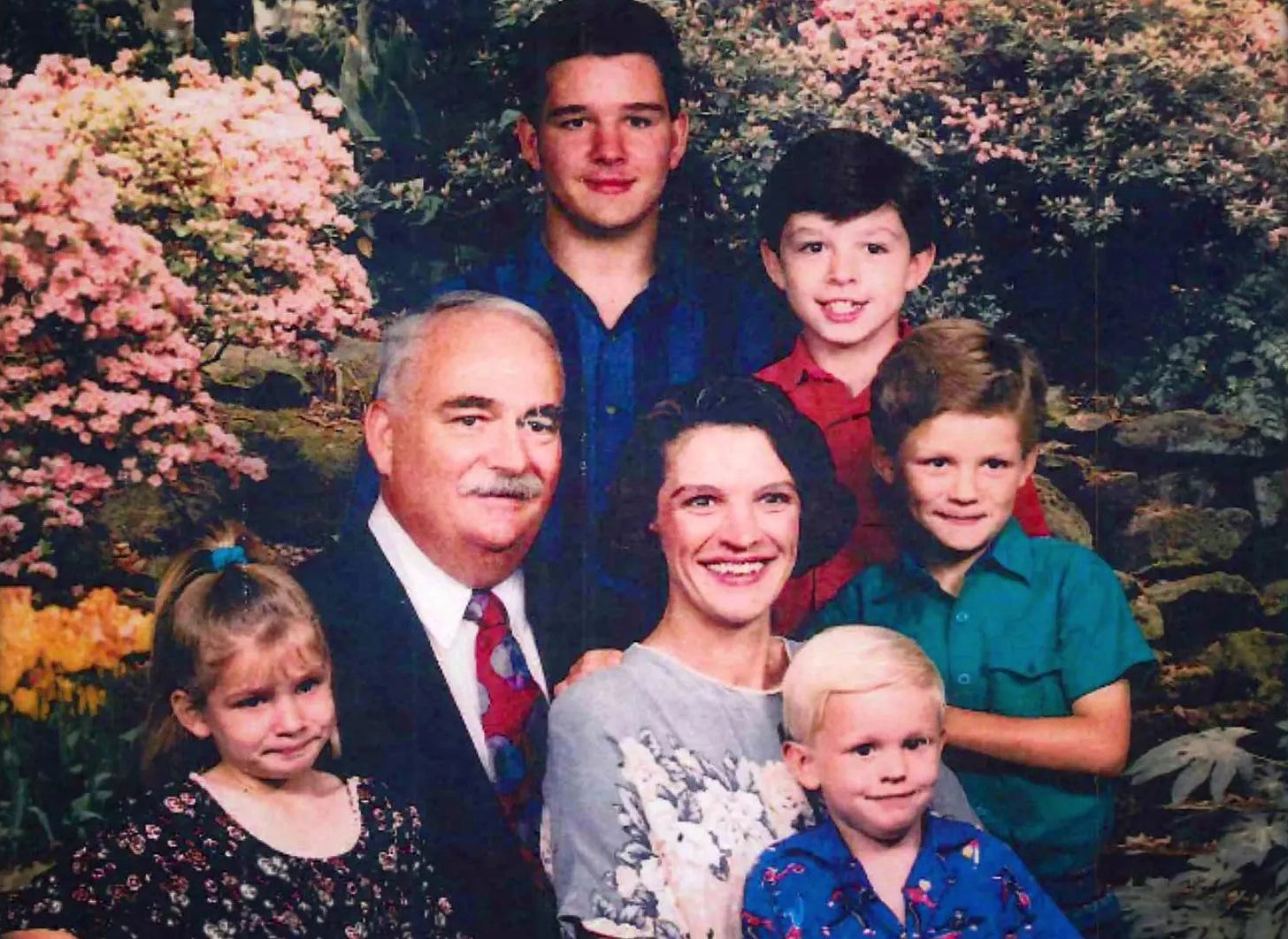
Police questioned all the other motel staff, including Glossip, but they didn’t go room to room. “At no time did Glossip direct the police to room 102, nor did he suggest that the police or anyone else check room 102,” the independent report states.
It wasn’t until 10 p.m. that night, after the police learned of the broken window in Room 102, that they bothered to check it out—and discovered the body of Barry Van Treese.
From the start, lead detective Bob Bemo was put off by Glossip, whom he called, in an interview with documentary filmmakers, “very arrogant and very cocky.”
After interrogating Glossip, Bemo was convinced the manager had something to do with the murder. Why hadn’t Glossip called the cops when Sneed confessed to him? Why hadn’t he peeked inside Room 102, where he would have found Van Treese’s body? It wasn’t until Glossip was interrogated a second time that he told detectives Sneed confessed to killing Van Treese. Why did he wait so long?
True, there was no forensic evidence, such as fingerprints or DNA, connecting Glossip to the crime scene, but it seemed as though Glossip was hiding something.
Bemo said of Glossip, in the interview with the filmmakers: he was “such a liar he wouldn’t know the truth if it hit him right between the eyes.” Bemo added that Sneed “wasn’t in it by himself, because he wasn’t smart enough.”
On January 14, 1997, the state formally charged Glossip with “accessory after the fact.” They knew Glossip had helped Sneed tidy up the crime scene, but they suspected he had masterminded the murder. They just couldn’t prove it yet.
When detectives Bemo and John Cook questioned Sneed, they kept insinuating that Glossip was to blame. The detectives brought up Glossip’s name six times during the first twenty minutes of the interrogation. Bemo also told Sneed that police had arrested Glossip, and that Glossip was blaming Sneed for the murder.
Soon enough, Sneed was telling the detectives what they wanted to hear: Glossip had planned Van Treese’s murder.
Glossip did it, Sneed said, because Van Treese was on the verge of firing him for stealing money from the motel.
According to the independent report, toward the end of the interrogation Sneed asked detectives: “So is this going to help me out any at all by telling you all this?”
Sneed clearly knew that implicating Glossip would help his case, the report states: “It is hard to imagine any reasonable person facing a first-degree murder charge not taking this lifeline signaled by police, even if it meant adopting an untruthful narrative.”
One week later, Glossip was charged with Murder 1 or “murder for hire”—a capital offense.
Meanwhile, Sneed was convicted of murder and sentenced to life in prison after reaching an agreement with the Oklahoma City District Attorney’s Office: he would testify against Glossip to avoid the death penalty.
The narrative that all of them—the cops, the prosecutors, Sneed—agreed on was that Sneed committed the actual murder but only because Glossip told him to do it.
Prosecutors later put it this way: “This case basically rests on the testimony of Mr. Sneed. The physical evidence basically all goes to Mr. Sneed. He’s the one who actually committed the murder. Our contention is that Mr. Glossip was the mastermind and that he enlisted Mr. Sneed to carry out the murder.”
In July 1998, Glossip was convicted of Murder 1—on the sole basis of Sneed’s testimony.
Glossip was sentenced to die.
The Glossip case was automatically appealed to the Oklahoma Court of Criminal Appeals—standard procedure in all death penalty cases in the U.S.—and in 2001, the court overturned Glossip’s conviction.
The court noted that Glossip was not, in fact, directly involved in the murder, and it was sharply critical of Glossip’s attorney, Wayne Fournerat, who had no experience trying capital cases, according to the anti–death penalty group Witness to Innocence, founded by Sister Helen Prejean. The Court of Criminal Appeals said: “Counsel’s conduct was so ineffective that we have no confidence that a reliable adversarial proceeding took place.”
Glossip was granted a retrial, and in light of the Court of Criminal Appeals’ ruling, he was cautiously optimistic that he would prevail.
But amazingly, he was convicted again.
There’s no doubt that this was partly due to the state having destroyed a box of evidence in 1999. It contained Van Treese’s handwritten deposit book and two receipt books that would likely have shown Glossip had not embezzled money from the Best Budget Inn, as prosecutors asserted.
The independent report states: “The State, as memorialized by multiple documents from both the Oklahoma County District Attorney’s Office and the Oklahoma County Police Department, expressly intended to destroy this evidence.”
Once again, on August 27, 2004, Glossip was sentenced to death.
To Glossip, it felt unreal. “Sometimes I think about how easy this happened, and how easily it can happen to somebody else,” he said.
For a long time, he didn’t see the sky or grass, other people, fences, birds, clouds. He was deep in death row—H Unit—and it felt a little like he was half-alive, half-dead.
“I’ve watched people who lose it, because you’re so isolated from people,” he said. “I’m one of those people that looks at a situation and says, ‘Hey, if I allow myself, that’s what I’m going to become and lose my mind.’ ” To avoid losing his mind, he wrote letters or worked out. “Just to make me feel like I’m normal, like I’m in a normal life. That’s what you have to do in a situation like this, or it will take control of you, it will take you over.”
Meanwhile, more doubts were shed on his conviction. In 2007, Sneed wrote a letter to his own defense lawyer confessing his regret over the Glossip case. “There are a lot of things right now that are eating at me,” he wrote. “Somethings [sic] I need to clean up. . . I think you know were [sic] I’m going it was a mistake reliving this.”
Sneed’s attorney wrote back to him, saying she could tell “some things are bothering you.” But she didn’t pursue the conversation further and, in 2020, she died. (Kevin McDugle would later say Sneed’s comments “strongly suggested” that Sneed wanted to recant his testimony against Glossip.)
Eight years after Sneed wrote his letter, in 2015, a juror who heard the Glossip case expressed distress over the entire trial.
Then, in 2016, Glossip got a card from Lea Rodger. She was a paralegal and an anti–death penalty activist, and at Christmastime, she sent cards to prisoners in Florida, Texas, and California. Glossip wrote back, and they started to exchange letters.
Eventually, the letters turned into phone calls, and then they met, and there was this automatic “connection,” Lea told me.
For four years they talked almost every day, and they swapped more letters, and she sent him photographs too. They were separated in age by nearly three decades but bound together in a shared cause: Glossip’s freedom.
In March 2022, they were married. He was 59 and she was 32.

His wedding day, Glossip said, was perfect—the correctional officers and prison bars notwithstanding. They exchanged vows. They held hands. “The most amazing thing for me,” Glossip said, “was my face hadn’t been touched in 25 years, and Lea reached up, and she put her hand on my face, and she pulled me down to her and kissed me.”
Over the past few years, Glossip said, he’s decorated the wall above his bed with photographs of his wife. He calls it his “wall of Lea.”
“We have lots of hopes and dreams for our future, all that we want together,” Lea told me as we sat in her apartment. She was seemingly buoyant and full of energy, despite the circumstances. “We say a prayer every night together over the phone that we’ll eventually get there.”
When I asked her why she was with Glossip—why an attractive woman in her early thirties with a promising career ahead of her would marry a man nearing 60 without a high school diploma—she seemed confused by my confusion.
“I did not want to be close to a death row inmate,” Lea said. “I kept him at arm’s length. I definitely kept him at a distance. I have witnessed inmates being executed. I was not looking to be close to him or anybody, so I put off talking to him for a while.”
She added: “It took a lot for me to get to the point to consider going down this path with him.”
Later, when I asked her to comment on the recent Supreme Court ruling, which means her husband could get another trial and even be exonerated, she texted me.
“Today feels like another answered prayer,” Lea said. “We continue to lean on our faith.”
It took a long time for all the facts of Richard Glossip’s life, his case, and his years in prison to seep out into the public.
“What started the needle moving quickly was those two botched executions,” Brett Farley, the executive director of Catholic Conference of Oklahoma, told me. He was referring to Clayton Lockett and Charles Warner, who was executed in early 2015. As Warner was put to death, he reportedly said: “My body is on fire.” (Their experiences were not dissimilar to that of Kenneth Eugene Smith, who was put to death in Alabama last week with a new, untried method: nitrogen gas. Smith reportedly shook and writhed. It took 22 minutes for him to die.)
Later, an autopsy of Warner’s body found that instead of using potassium chloride, as the state requires, he had been executed using potassium acetate—the same drug used on Clayton Lockett.
Making matters worse, a prison official appeared to have tampered with Warner’s execution log—which falsely stated that the prison had used potassium chloride to execute him.
After Warner’s autopsy, Mary Fallin, Oklahoma’s then-governor, called off Glossip’s 2015 execution due to “last-minute questions” about the state’s “execution protocol and the chemicals used for lethal injection.” She then declared a temporary moratorium on all executions as the state investigated its procedures.
“Until we have complete confidence in the system, we will delay any further executions,” Fallin said.
That was when Republicans started to wonder what was going on, said Brett Farley.
Farley was once a spokesman for the state GOP. He is on the right wing of the right wing of the party, but he said he is disgusted by the system—the district attorneys, the state’s Pardon and Parole Board. He said he and others wanted to know: How was it that elected officials did not appear to have control over their own capital punishment apparatus?
“That forced everyone to take a look at what’s happening, where prior to that it was just sort of, ‘Well, this is what we do, and bad guys get executed,’ ” Farley said.
Then, in late October 2021, Oklahoma resumed executing prisoners, starting with John Grant—who vomited repeatedly after the sedative midazolam was administered. Grant was conscious for another 15 minutes before he died.
In February 2022, a bipartisan group of state legislators commissioned the international law firm Reed Smith to conduct an investigation of the Glossip case. In June of that year, Stan Perry, the lead attorney on the investigation, submitted his report.
“No reasonable jury, hearing the complete record and the uncovered facts detailed in this report, would have convicted Richard Glossip of capital murder,” Perry said.
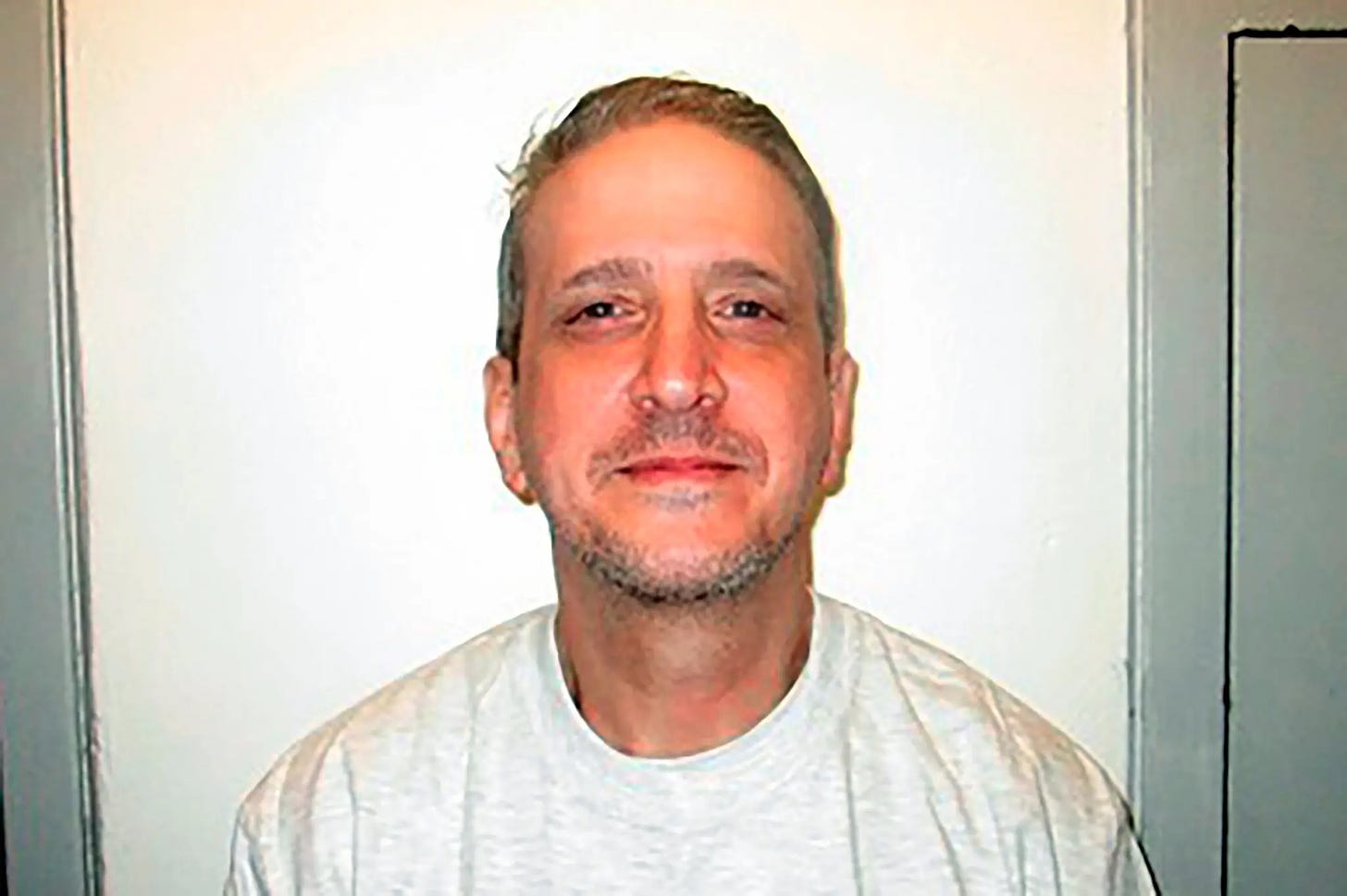
J.J. Humphrey, a Republican state representative who supports capital punishment, told me all the DAs and other state politicos who built their careers being tough on crime are to blame for refusing to admit they got Glossip’s case wrong.
“People can’t have faith in the system. That’s what tears down your country, and this is as corrupt as it gets—to take a person’s life to further your political career. That’s what’s been done in Richard’s case.”
In July 2022, Oklahoma’s Republican, pro–death penalty attorney general, Gentner Drummond, filed a brief with the Supreme Court acknowledging that his office had done a shoddy job on the Glossip case, stating: “Justice would not be served by moving forward with a capital sentence that the State can no longer defend.”
In October 2023, Republicans convened a panel to consider imposing a death penalty moratorium again—despite two-thirds of Oklahoma voters supporting capital punishment.
And yet, it doesn’t matter that almost all the powerful people are now on Glossip’s side. That includes Oklahoma’s current Republican governor Kevin Stitt, who has granted Glossip two stays of execution.
That’s because Oklahoma’s Pardon and Parole Board still refuses to recommend commuting Glossip’s sentence. In spring 2023, the board voted 2–2 against recommending that the governor commute Glossip’s sentence to life without parole. (Three votes are required for a recommendation. The fifth board member recused himself because his wife is a prosecutor who worked on the Glossip case.)
“Their core belief is, ‘If we admit that we did wrong in the past on one case, then we have to admit that we did wrong on other cases—so, we need to act like there was never anything to see here,’ ” Kevin McDugle, the state representative, said of the parole board.
Adam Luck, a former parole board member who stepped down in 2022, seems to agree the board is compromised. In July, in a speech before the Oklahoma Coalition to Abolish the Death Penalty, Luck said that after publicly raising questions about the death penalty, he received a threatening call from a district attorney. (He declined to provide names.) Requests for comment from the offices of the Oklahoma City District Attorneys Council and the Oklahoma Pardon and Parole Board went unanswered as of press time on Monday.
McDugle and Luck added that the Oklahoma District Attorneys Council—a state government agency that supports Oklahoma’s 27 elected district attorneys—wields outsize influence over the parole board. Three of the five parole board members have previously sat on the District Attorneys Council.
“They have their fingers in everything,” McDugle said. “How can you get a fair hearing when the majority of the people are the ones wanting to put you away?”
That was the nub of it, Farley agreed.
“If they open up this can of worms, it’s going to mean restructuring the whole prosecution end of the equation,” Farley told me. “It may mean that we have to question whether district attorneys should be elected at all, or should they be appointed instead.”
In the meantime, Glossip sits on death row in the penitentiary in McAlester, along with 35 other prisoners across the two units. Five years ago, he was moved to the upstairs A unit, which has a better view. “It’s a much better place, because you have the window, so you can see all these interactions taking place outside,” he told me.
Glossip said that for now, he tries not to think too much about the legal ins and outs of his case—the appeals, the motions. Instead, he prefers to think about his wife, with whom he has never spent a minute alone, and who he has never slept with. (Oklahoma does not permit conjugal visits.) He sees her weekly—she drives down from Oklahoma City and visits him every Friday. And, of course, he has his wall of Lea.
“We try every day to live as a married couple,” Glossip said. They speak a lot on the phone. (That can be annoying, since calls automatically cut off after 20 minutes, and Glossip has to call back.) “I’m there when she dries her hair, when she puts on her makeup. I take the ride to school”—she’s getting her law degree—“I take the ride back. We eat dinner together. We watch TV together. We do all these things so that we can be a married couple, so that we can continue to grow.”
Some nights, they go to bed together listening to music. “We create playlists,” Lea says. “Richard picks ten songs, and I pick ten songs, and then we’ll start it at the same time so we know that even though we’re physically apart, we’re sharing music in that moment together.”
After so many years without hope, Glossip finally has reason to believe he will see the outside world once again. He feels his future has promise, partly because the Supreme Court has agreed to hear his case. But mainly because of Lea.
“Since Lea came into my life,” he told me, “I know that day is coming soon where her and I will be standing out there in the sun and enjoying and breathing the air.”
CORRECTION: A previous version of this story incorrectly stated that the name of Justin Sneed’s girlfriend at the time of the murder was Stephanie Garcia. Garcia, in fact, is a witness who showed up later in the case. The Free Press regrets the error.
Rupa Subramanya is a reporter for The Free Press. Read her last article, “Is Justice Still Blind in Canada?” and follow her on X, formerly Twitter, @rupasubramanya.
To support more of our work, become a Free Press subscriber today:

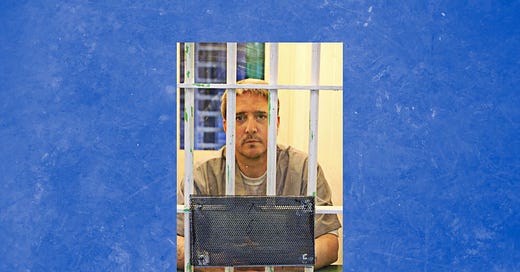










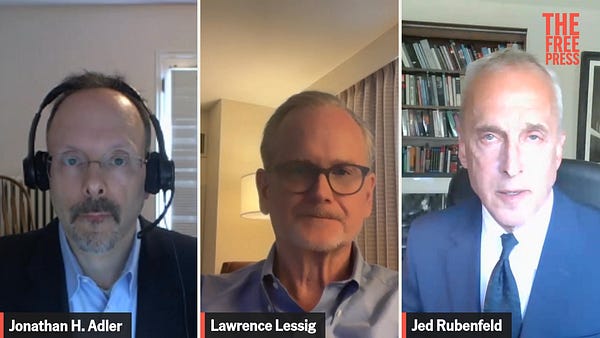







“…with Texas in first place and Oklahoma at No. 2. (Oklahoma, with its much smaller population, actually has a higher execution rate than Texas does.)”
This is not how you calculate the rate of execution.
One must compare the number of executed inmates to the total population of death row inmates not the population of the whole state.
This is the same error that claims blacks are sentenced to death at a higher rate than whites. The statistic compares DP by national percentage of black people ~13% rather than comparing that number to the total number of convicted murderers.
Anybody who streams content has seen a zillion mysteries/court cases of Hollywood story-telling and love to speculate on cases like this. Having covered a few murder trials, I saw where law enforcement's judgement is not a perfect record, with complex individual motives and bias that can rival the criminal's; but Glossip went from a role of promising hospitality management to a descent into motel hell. His actions after the event were despicable, but testimony alone is probably a weak death penalty case. As to this case abolishing the death penalty, keep wishing. It serves a noble purpose that many times expresses the wishes of the victim's family, who has been exponentially hurt for decades compared to the perpetrator(s). If you have ever spent time with criminals in a jail, after getting hit up for cigarettes/drugs, they will ALL proclaim their innocence.